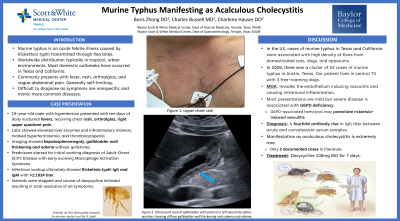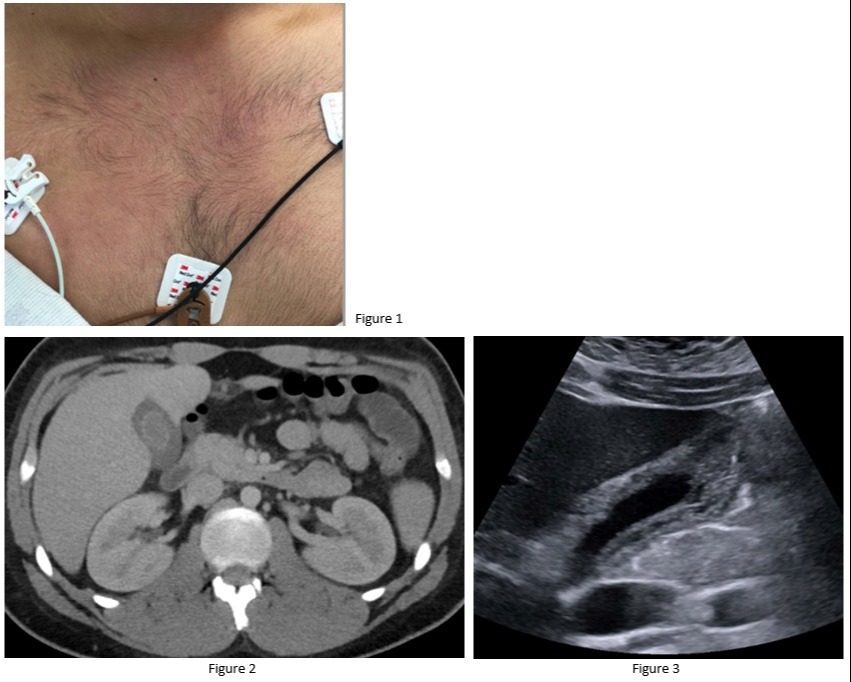Monday Poster Session
Category: Biliary/Pancreas
P1562 - Murine Typhus Manifesting as Acalculous Cholecystitis
Monday, October 23, 2023
10:30 AM - 4:15 PM PT
Location: Exhibit Hall

Has Audio
- BZ
Boris Zhong, DO
Baylor Scott & White
Temple, TX
Presenting Author(s)
Boris Zhong, DO1, Charles Bussell, MD2, Charlene A. Hauser, DO3, Mauricio Jones, DO1
1Baylor Scott & White, Temple, TX; 2Baylor Scott & White Health, Temple, TX; 3Baylor Scott & White, Harker Heights, TX
Introduction: Murine typhus is an acute febrile illness caused by Rickettsia typhi transmitted through flea bites. Patients commonly present with fever, rash, arthralgias, and vague abdominal pain. Diagnosis is made with serologic testing and preferred treatment is with tetracycline though it can be self-limiting. We highlight an extremely rare case of murine typhus presenting with acalculous cholecystitis.
Case Description/Methods: A 19-year-old male with hypertension presented with ten days of daily nocturnal fevers, recurring chest rash, arthralgias, right upper quadrant pain and SIRS. Initial labs showed elevated liver enzymes and inflammatory markers, marked hyperferritinemia, and thrombocytopenia. Imaging showed hepatosplenomegaly, gallbladder wall thickening, and edema, without gallstones. Initial working diagnosis was Adult-Onset Still’s Disease (AOSD) with early evolving Macrophage Activation Syndrome and prednisone provided initial symptomatic improvement. Infectious workup ultimately showed Rickettsia typhi IgG and IgM with >1:1024 titer. This finding significantly decreased the likelihood of AOSD, so steroids were stopped, and a course of doxycycline 100 mg twice daily was initiated resulting in total resolution of all symptoms by completion of course.
Discussion: Murine typhus has a worldwide distribution typically in tropical, urban environments, with most domestic outbreaks occurring in Texas and California. These cases were associated with high density of affected domestic animals or opossums1. Our patient resides in central Texas with three dogs as the likely vector for infection. His non-specific symptoms are typical for rickettsial infection, however, the finding of acalculous cholecystitis is exceptionally rare2. In cases where cholecystectomy was performed, histology demonstrated rickettsial invasion of the endothelium inducing vasculitis and intramural inflammation3. This explains the initial favorable response to steroid therapy. Rickettsial infections can masquerade as inflammatory diseases with non-specific rises in liver enzymes and ferritin, making autoimmune disorders high on the differential. A fourfold antibody rise in IgG titer between acute and convalescent serum samples is diagnostic for murine typhus4. We have only discovered a handful of documented cases of murine typhus associated with acalculous typhus which makes this a unique case 5,6. Murine typhus is an underdiagnosed infection that should be considered in endemic areas during diagnostic testing and empiric treatment.

Disclosures:
Boris Zhong, DO1, Charles Bussell, MD2, Charlene A. Hauser, DO3, Mauricio Jones, DO1. P1562 - Murine Typhus Manifesting as Acalculous Cholecystitis, ACG 2023 Annual Scientific Meeting Abstracts. Vancouver, BC, Canada: American College of Gastroenterology.
1Baylor Scott & White, Temple, TX; 2Baylor Scott & White Health, Temple, TX; 3Baylor Scott & White, Harker Heights, TX
Introduction: Murine typhus is an acute febrile illness caused by Rickettsia typhi transmitted through flea bites. Patients commonly present with fever, rash, arthralgias, and vague abdominal pain. Diagnosis is made with serologic testing and preferred treatment is with tetracycline though it can be self-limiting. We highlight an extremely rare case of murine typhus presenting with acalculous cholecystitis.
Case Description/Methods: A 19-year-old male with hypertension presented with ten days of daily nocturnal fevers, recurring chest rash, arthralgias, right upper quadrant pain and SIRS. Initial labs showed elevated liver enzymes and inflammatory markers, marked hyperferritinemia, and thrombocytopenia. Imaging showed hepatosplenomegaly, gallbladder wall thickening, and edema, without gallstones. Initial working diagnosis was Adult-Onset Still’s Disease (AOSD) with early evolving Macrophage Activation Syndrome and prednisone provided initial symptomatic improvement. Infectious workup ultimately showed Rickettsia typhi IgG and IgM with >1:1024 titer. This finding significantly decreased the likelihood of AOSD, so steroids were stopped, and a course of doxycycline 100 mg twice daily was initiated resulting in total resolution of all symptoms by completion of course.
Discussion: Murine typhus has a worldwide distribution typically in tropical, urban environments, with most domestic outbreaks occurring in Texas and California. These cases were associated with high density of affected domestic animals or opossums1. Our patient resides in central Texas with three dogs as the likely vector for infection. His non-specific symptoms are typical for rickettsial infection, however, the finding of acalculous cholecystitis is exceptionally rare2. In cases where cholecystectomy was performed, histology demonstrated rickettsial invasion of the endothelium inducing vasculitis and intramural inflammation3. This explains the initial favorable response to steroid therapy. Rickettsial infections can masquerade as inflammatory diseases with non-specific rises in liver enzymes and ferritin, making autoimmune disorders high on the differential. A fourfold antibody rise in IgG titer between acute and convalescent serum samples is diagnostic for murine typhus4. We have only discovered a handful of documented cases of murine typhus associated with acalculous typhus which makes this a unique case 5,6. Murine typhus is an underdiagnosed infection that should be considered in endemic areas during diagnostic testing and empiric treatment.

Figure: Figure 1. Upper chest rash
Figure 2. Coronal view of abdominal CT showing gallbladder wall edema
Figure 3. Ultrasound view of gallbladder with patient in left lateral decubitus position showing diffuse gallbladder wall thickening and submucosal edema
Figure 2. Coronal view of abdominal CT showing gallbladder wall edema
Figure 3. Ultrasound view of gallbladder with patient in left lateral decubitus position showing diffuse gallbladder wall thickening and submucosal edema
Disclosures:
Boris Zhong indicated no relevant financial relationships.
Charles Bussell indicated no relevant financial relationships.
Charlene Hauser indicated no relevant financial relationships.
Mauricio Jones indicated no relevant financial relationships.
Boris Zhong, DO1, Charles Bussell, MD2, Charlene A. Hauser, DO3, Mauricio Jones, DO1. P1562 - Murine Typhus Manifesting as Acalculous Cholecystitis, ACG 2023 Annual Scientific Meeting Abstracts. Vancouver, BC, Canada: American College of Gastroenterology.
